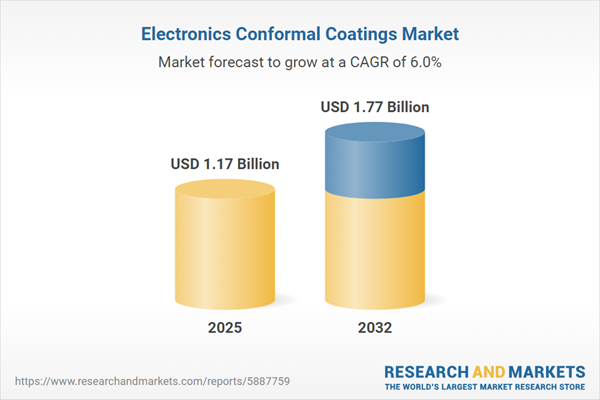Speak directly to the analyst to clarify any post sales queries you may have.
Electronics conformal coatings are increasingly recognized as mission-critical components in safeguarding electronic assemblies, helping decision-makers stay ahead in competitive, technology-driven verticals.
Market Snapshot: Electronics Conformal Coatings Market Size and Growth
The Electronics Conformal Coatings Market grew from USD 1.11 billion in 2024 to USD 1.17 billion in 2025. It is expected to continue growing at a CAGR of 6.02%, reaching USD 1.77 billion by 2032. The growing market is driven by evolving electronics manufacturing standards, heightened end-user expectations, and advancements in protective coating technologies. Senior leaders should note the market’s strong momentum and responsiveness to rapid changes in device miniaturization, connectivity, and global compliance frameworks.
Scope & Segmentation
This comprehensive report analyzes and forecasts developments across all critical segments:
- Coating Material: Acrylic, Epoxy, Parylene, Polyurethane, Silicone, and Styrenated Block-copolymer systems are evaluated for their suitability and performance in various operating conditions.
- Application Method: Includes Brush Coating, Dip Coating, Selective Coating, and Spray Coating, with each supporting specific production volumes and board designs.
- Thickness Range: Segmented as Less Than 25 Microns, 25–100 Microns, and Over 100 Microns to align protective strategies with assembly needs and cost controls.
- Curing System: Examined across Evaporative, Moisture, Thermal, and UV Curing, which address throughput, efficiency, and sustainability goals.
- End-User: Aerospace & Defense, Automotive & Transportation, Consumer Electronics, Energy & Utilities, Healthcare & Life Sciences, Information Technology & Telecommunication, and Manufacturing are assessed for their distinct requirements and drivers.
- Regional Coverage: The Americas, Europe, Middle East & Africa, and Asia-Pacific—each analyzed for regulatory trends, manufacturing capabilities, and demand catalysts.
- Key Player Developments: Tracks innovative strategies, technology roadmaps, and new product introductions among global market leaders and emerging entities.
Key Takeaways from the Electronics Conformal Coatings Market
- Emerging material technologies—such as nanocomposites and bio-based options—are reshaping what is possible for performance and sustainability in demanding electronic applications.
- Digital transformation in production offers real-time process monitoring, leading to gains in coating consistency and reduced waste, helping drive production efficiency and lower operational risks.
- Market participants are increasingly prioritizing low-emission and solvent-free chemistries to comply with eco-driven regulations and to support corporate ESG objectives.
- End-user sectors are demanding tailored coating solutions that balance stringent reliability with cost targets, accelerating collaboration between suppliers and OEMs across critical applications.
- Localization of production facilities and material sources is rising in importance, as regional supply chain resilience and tariff avoidance are now strategic imperatives.
- Collaboration across suppliers, equipment vendors, and quality standard bodies is resulting in harmonized product specifications and benchmarks, supporting efficient adoption of new technologies at scale.
Tariff Impact on the Electronics Conformal Coatings Market
Recent United States trade tariffs on specialty raw materials and deposition equipment have increased cost pressures throughout the value chain. Strategic sourcing diversification and reshoring of select production steps have helped market participants manage volatility. While immediate effects include capital investment delays and procurement shifts, firms that adapt by consolidating logistics and sharing development risks with partners are securing sustained competitiveness.
Methodology & Data Sources
This analysis leverages a robust, multi-stage methodology that blends secondary research with in-depth executive interviews, technical forums, and expert panels. Insights are cross-verified through quantitative supply-chain data and regional trade flows. Rigorous segmentation and triangulation support accurate, actionable conclusions for decision-makers.
Why This Report Matters
- Enables strategic planning by delivering clear intelligence on emerging technologies, segmentation, and evolving end-user needs in the electronics conformal coatings market.
- Supports resilient procurement and sourcing strategies through detailed coverage of tariff impacts, regulatory trends, and localization efforts.
- Offers insight into the competitive landscape, highlighting the moves of leading players and innovators with information critical for M&A or strategic partnerships.
Conclusion
This report provides senior decision-makers with the clarity needed to navigate a complex and fast-evolving market. Acting on these insights will help organizations optimize protective strategies and capitalize on new growth frontiers in advanced electronic assemblies.
Additional Product Information:
- Purchase of this report includes 1 year online access with quarterly updates.
- This report can be updated on request. Please contact our Customer Experience team using the Ask a Question widget on our website.
Table of Contents
3. Executive Summary
4. Market Overview
7. Cumulative Impact of Artificial Intelligence 2025
Companies Mentioned
The companies profiled in this Electronics Conformal Coatings market report include:- Aalpha Conformal Coatings
- AI Technology, Inc.
- Avantor, Inc.
- Chase Corporation
- CHT Germany GmbH
- Conins Pune
- CSL Silicones Inc. by PETRONAS Chemicals Group Berhad
- Dymax Corporation
- ELANTAS GmbH by ALTANA Group
- Electrolube
- H.B Fuller Company
- Henkel AG & Co. KGaA
- Illinois Tool Works Inc.
- MG Chemicals
- Micron Aerosol by Deepak Industries
- Miller-Stephenson Chemical, Inc.
- Momentive Performance Materials Inc.
- MR BOND POLYCHEM
- RS Components & Controls (I) Ltd.
- Shanghai Huitian New Material Co., Ltd.
- Shin-Etsu Chemical Co., Ltd.
- Specialty Coating Systems Inc. by KISCO Ltd.
- The Dow Chemical Company
- Vinsa Chemicals Private Limited
Table Information
| Report Attribute | Details |
|---|---|
| No. of Pages | 194 |
| Published | November 2025 |
| Forecast Period | 2025 - 2032 |
| Estimated Market Value ( USD | $ 1.17 Billion |
| Forecasted Market Value ( USD | $ 1.77 Billion |
| Compound Annual Growth Rate | 6.0% |
| Regions Covered | Global |
| No. of Companies Mentioned | 25 |









